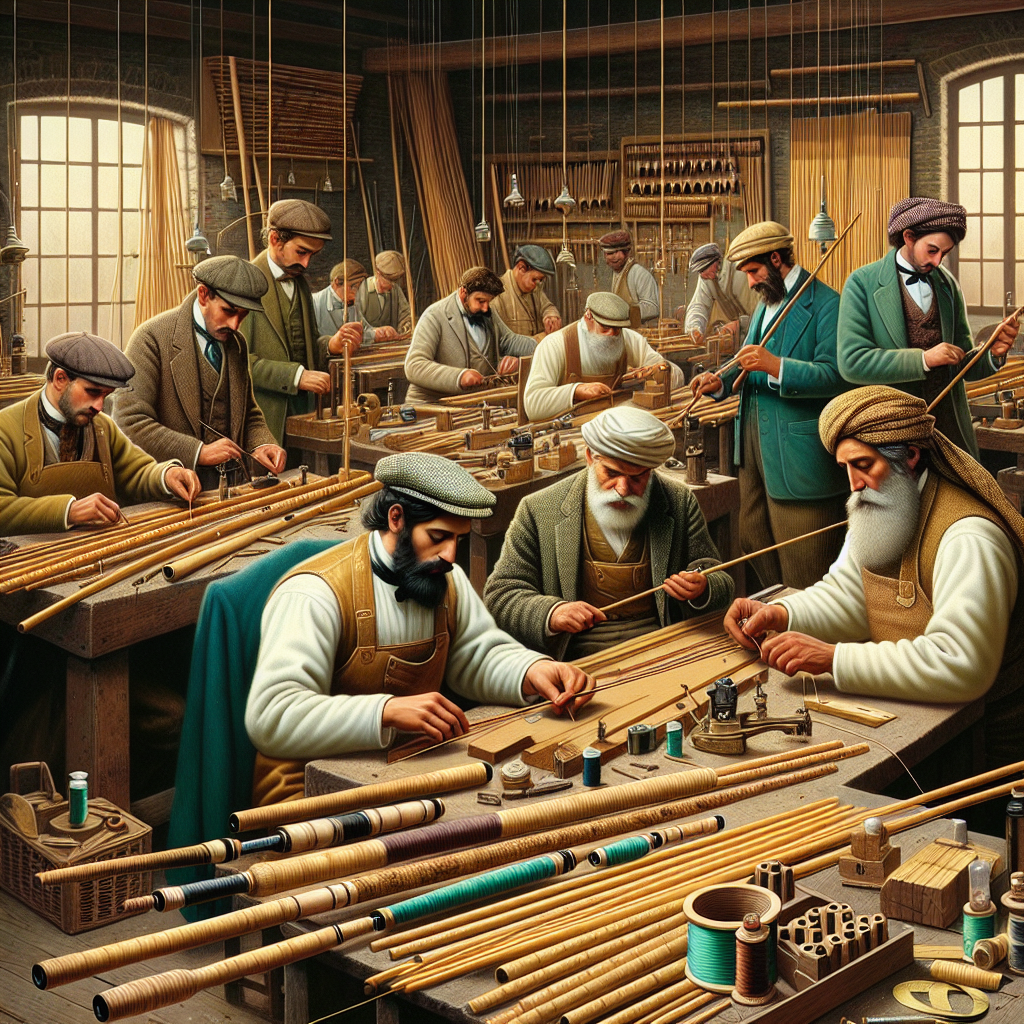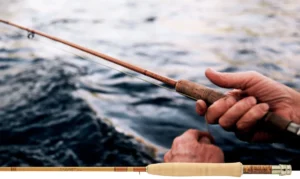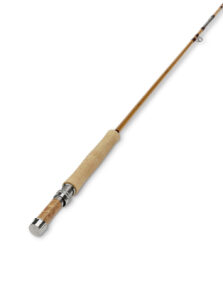
Article-At-A-Glance:
-
Hiram Leonard set the standard for modern bamboo fly rods with his hexagonal design.
-
Leonard’s foundational techniques continue to influence contemporary rod builders.
-
Payne Rod Company rods are prized for their quality and have become collectible items.
-
Thomas and Thomas rods are celebrated for their artisanal approach and custom craftsmanship.
-
Bamboo fly rods are not just fishing tools; they are heirlooms, works of art, and pieces of angling history.
Stay tuned as we continue to explore the intricate world of bamboo fly rod makers and custom builders, where every rod tells a story of tradition, innovation, and the relentless pursuit of perfection.
Craftsmen of Elegance: The Masters of Bamboo Fly Rods
Imagine a tool so perfectly crafted it feels like an extension of your own body. That’s what a bamboo fly rod made by a master craftsman can be for an angler. These rods aren’t just fishing equipment; they’re works of art, meticulously shaped from a plant into a precision instrument for sport.
1. The Legacy of Hiram Leonard: Innovator of the Hexagonal Rod
Hiram Leonard’s name is etched in history as the pioneer of the hexagonal bamboo fly rod. His vision and skill set a new standard in rod making, transforming the craft into what we know and admire today. Leonard’s rods were not just tools for fishing; they were a statement of elegance and innovation.
Foundational Design Techniques
Leonard’s approach to rod making was revolutionary. He introduced the six-strip method, moving away from the traditional solid bamboo rods. This technique improved the rod’s flexibility and strength, giving anglers more precision and control. Each strip was carefully selected, cut, and planed to perfection, ensuring a balanced and responsive rod.
The Impact on Modern Rod Building
The hexagonal design pioneered by Leonard is still the foundation of modern bamboo rod building. His influence extends beyond the design; it’s about the philosophy of craftsmanship, the dedication to creating something exceptional from natural materials. Today’s rod builders still look to Leonard’s methods for inspiration, striving to match his level of artistry.
2. Payne Rod Company: Synonymous with Quality
The Payne Rod Company represents a legacy of quality that has stood the test of time. These rods are revered for their craftsmanship and performance. When you hold a Payne rod, you’re holding a piece of angling history, a connection to a tradition of excellence that has influenced generations of rod makers.
Payne’s Signature Style and Construction
Payne rods are known for their distinctive style, characterized by precise tapers and a smooth action that many anglers swear by. The company’s commitment to using the finest bamboo and hardware has set a benchmark for quality in the industry. Each rod is a testament to the skill and attention to detail that goes into its creation.
Collectibility and Continuing Influence
The allure of a Payne rod extends beyond its fishing capabilities. Collectors value these rods for their historical significance and the craftsmanship they represent. As a testament to their enduring appeal, the techniques and designs of Payne rods continue to inspire new generations of custom rod builders around the world.
3. Thomas and Thomas: The Artisans’ Choice
In the world of custom bamboo fly rods, Thomas and Thomas stand out as a brand chosen by artisans. Their commitment to handcrafting each rod from start to finish ensures a level of quality and individuality that is unmatched. With a Thomas and Thomas rod in hand, anglers can feel the passion and expertise woven into every cast.
Precision and Performance in Every Creation
Each bamboo fly rod from Thomas and Thomas is a showcase of precision. The makers understand that performance is paramount, and they achieve this by marrying time-honored techniques with modern precision tools. The result is a rod that not only looks stunning but performs with a responsiveness that can turn a day on the water into a dance with nature.
Present-Day Masters Carrying the Torch
Today’s masters of bamboo rod making carry forward the legacy of their forebears. They are a blend of artist and engineer, infusing each rod with the soul of tradition and the heartbeat of innovation. These artisans ensure that the craft not only survives but thrives, evolving with each handcrafted piece.
The Alchemy of Bamboo: From Plant to Prestige
The journey from a raw bamboo culm to a finished fly rod is one of transformation. It’s an alchemy that turns a simple grass into a conduit of sport and tradition. This process is both an art and a science, requiring knowledge, patience, and a deep respect for the material.
Understanding the Material: Intro to Bamboo’s Qualities
Bamboo is the soul of the fly rod. Its natural properties—strength, flexibility, and resilience—make it an ideal material for crafting rods. But not all bamboo is created equal. The species, the age, and even the climate where it grew all contribute to the character of the final rod.
The Selection Process of Bamboo for Rod Making
Selecting the right bamboo is critical. Rod makers look for culms with dense fibers and a consistent diameter. They seek out bamboo that has matured just enough to have the strength needed for a rod that can battle the pull of a fish yet remain light in the hand.
Curing Techniques for Durability
Curing the bamboo is a step that cannot be rushed. This process stabilizes the fibers, reduces moisture content, and enhances the bamboo’s natural resilience. A well-cured bamboo culm will result in a rod that can withstand the rigors of the river for years to come.
The Stepping Stones to a Bamboo Fly Rod
The path to creating a bamboo fly rod is paved with meticulous steps. Each phase of the process builds upon the last, moving steadily towards the goal of a rod that feels alive in the hands of the angler. It’s a journey of transformation, from plant to prestige.
Splitting and Shaping: The Beginning of the Rod
The first step is to split the bamboo into long, slender strips. These strips are then shaped with precision, their edges planed to fit together seamlessly. This is where the rod begins to take form, where the potential of the bamboo starts to be realized.
Binding and Gluing: The Hidden Strength
Once the bamboo strips are shaped, they are bound and glued together, forming the rod’s blank. This step is crucial—it’s where the rod gains its backbone. The glue must be applied with care, ensuring a bond that holds tight when the rod bends and flexes. It’s a hidden strength, not seen by the eye, but felt with every cast.
Finishing Touches: Varnishing and Wrapping
The final steps in rod making are where beauty meets function. Varnishing not only protects the bamboo from water and wear, it also brings out the natural luster of the wood. Wrapping the guides with silk thread is a meticulous process, adding color and character to the rod. These finishing touches are what make each rod unique, a reflection of the maker’s style and the angler’s personality.
Masterpieces in Motion: The Feel of a Bamboo Rod
When you cast a bamboo fly rod, you’re engaging with a masterpiece in motion. The rod comes alive, its action speaking to the rhythm of the water and the dance of the fly. It’s an experience that connects the angler to the craft of the rod maker and the spirit of the sport.
Understanding the Bamboo Rod’s Unique Action
The action of a bamboo rod is its signature, a fingerprint that tells you how it will cast, how it will feel when a fish strikes, and how it will handle the fight. This unique action is a result of the rod’s taper, the quality of the bamboo, and the maker’s skill. It’s what makes each rod an individual, with a personality all its own.
Defining Action and How It Affects Your Cast
Action is a term that describes how a rod bends and moves. A fast-action rod bends mostly near the tip, offering speed and distance. A medium-action rod bends through the middle, providing a balance of power and finesse. A slow-action rod bends down into the butt section, giving a gentle, full-bodied cast. Understanding this will help you choose a rod that matches your casting style and the rhythm of your fishing waters.
Matching Rod to River: Choosing the Right Bamboo Rod
Choosing the right bamboo rod is like selecting the perfect dance partner—it’s all about harmony. The rod must complement the river’s character and the fish you’re targeting. It’s a decision that can elevate your fishing experience to an art form.
Factors to Consider: Fish Species and Water Conditions
When selecting a bamboo rod, consider the fish you’re after and the waters you’ll be navigating. A delicate rod for small mountain streams and native brook trout, or a sturdier build for battling steelhead in rushing waters. Each scenario demands a rod with specific qualities to enhance your connection to the environment and the sport.
A Living Legacy: Preserving the Tradition
The tradition of bamboo fly rod making is a living legacy, passed down through generations of craftsmen. It’s a heritage of skill, passion, and dedication to the art of angling. Preserving this tradition is about more than keeping the craft alive; it’s about honoring the history and the stories woven into the fabric of the sport.
Collectors’ Corner: The Market for Antique Bamboo Rods
The allure of antique bamboo rods goes beyond their use on the water. They are treasured as collectibles, pieces of angling history that hold stories of past adventures and craftsmanship. The market for these rods is vibrant, with enthusiasts around the world seeking to add a touch of history to their collections.
What Makes a Rod Collectible?
A rod’s collectibility can be influenced by several factors:
-
Maker’s Reputation: Rods crafted by renowned makers like Hiram Leonard or E.W. Edwards are highly sought after.
-
Rarity: Limited edition series or rods from makers who produced in small quantities.
-
Condition: Rods that have been well-maintained or restored to their original glory.
-
Provenance: Rods with a documented history or previous ownership by notable individuals.
-
Age: Older rods, especially those from the golden era of fly fishing, are particularly valuable.
-
Original Components: Rods with original bags, tubes, and fittings are more desirable.
Navigating the Purchase of Vintage Rods
When looking to purchase a vintage rod, it’s important to do your homework. Research the maker and model, understand the fair market value, and inspect the rod thoroughly for signs of wear or repair. Buying from reputable dealers or auction houses can provide assurance of authenticity and condition.
Adopting the Rod-Maker’s Mantle: DIY Tips
For those inspired to try their hand at rod-making, the journey begins with learning and practice. With the right resources and a bit of patience, anyone can start crafting their own bamboo fly rod, continuing the tradition of this fine art.
Knowledge Sources and Starter Kits
Begin by absorbing knowledge from books, online forums, and videos from seasoned rod makers. Starter kits are available that provide pre-planed bamboo strips and all the necessary components. These kits can be an excellent way to get a feel for the process before diving into more advanced techniques.
Workshops and Communities
Workshops led by experienced rod makers offer hands-on learning and are a great way to immerse yourself in the craft. Additionally, joining a community of like-minded individuals can provide support, trade secrets, and maybe even a mentor to guide you on your rod-making journey.
Article-at-a-Glance: Key Takeaways
-
Bamboo fly rods are not just tools for fishing; they are handcrafted pieces of art.
-
The legacy of renowned rod makers like Hiram Leonard and the Payne Rod Company continues to influence modern rod building.
-
Antique bamboo rods are highly collectible, with their value influenced by factors such as the maker’s reputation, rarity, and condition.
-
For aspiring rod makers, starter kits and workshops are invaluable resources for learning the craft.
-
Joining a community of bamboo rod enthusiasts can provide support and deepen your understanding and appreciation of the art.
FAQ: An Angler’s Inquiry
Anglers often have questions about bamboo fly rods, whether they’re seasoned pros or newcomers to the sport. Let’s tackle some of the most common inquiries:
What distinguishes bamboo rods from other rod types?
Bamboo rods are known for their smooth, natural action and the unique feel they provide, which many anglers find more responsive and tactile compared to synthetic rods. The craftsmanship and tradition behind each bamboo rod also set them apart.
Why are bamboo rods so expensive?
The cost reflects the time-intensive process of handcrafting each rod, the quality of materials, and the expertise involved. Bamboo rods are often seen as investments or heirlooms, not just as fishing tools.
How do I care for a bamboo fly rod to ensure longevity?
Proper care includes cleaning the rod after use, storing it in a cool, dry place, and regularly checking for any signs of wear or damage. Occasional light varnishing can also help protect the bamboo from the elements.
Can I still find new bamboo rods being made today?
Absolutely! There are many talented rod makers who continue to craft bamboo rods. These artisans blend traditional techniques with modern innovations to create rods that honor the past while embracing the present.
Do bamboo rods require special casting techniques?
While bamboo rods can be used with standard casting techniques, their unique action may require slight adjustments for optimal performance. Many anglers find that a slower, more deliberate casting stroke complements the natural flex of a bamboo rod.
What distinguishes bamboo rods from other rod types?
Bamboo rods are set apart by their distinctive feel and action. Unlike modern graphite or fiberglass rods, bamboo rods flex in a slower, more graceful manner, offering a tactile experience that’s often described as ‘soulful’. This natural material has a unique ability to connect the angler with the rhythms of the water and the subtleties of the fish’s movements.
Why are bamboo rods so expensive?
The price tag on a bamboo rod reflects the artistry and time required to create it. Each rod is handcrafted, often requiring over 40 hours of work. The bamboo itself is carefully selected and cured, and the components are often custom-made. This level of craftsmanship, combined with the rod’s longevity and the experience it provides, justifies the investment.
How do I care for a bamboo fly rod to ensure longevity?
To ensure your bamboo rod lasts for generations, it’s crucial to give it proper care. Always hand dry your rod after use and store it in a rod tube to protect it from the elements. Avoid extreme temperatures, and every so often, apply a light coat of varnish to preserve the bamboo’s integrity. Handle the rod with care, and it will continue to perform beautifully year after year.
Can I still find new bamboo rods being made today?
Yes, the tradition of making bamboo rods is alive and well. Artisans around the world continue to craft these rods, combining classic techniques with contemporary design elements. These modern bamboo rods honor the legacy of the past while delivering the performance expected by today’s discerning anglers.
Do bamboo rods require special casting techniques?
Bamboo rods do indeed have their own casting rhythm. They generally benefit from a slower, smoother casting stroke, allowing the rod to load and unload with the natural timing of the bamboo. This doesn’t mean a steep learning curve; it’s more about adapting and savoring the dance between angler, rod, and river.
In closing, the world of bamboo fly rod makers is a tapestry rich with history, artistry, and a deep connection to the natural world. These rods are more than just tools; they are the heart of a story that begins with a simple bamboo shoot and ends with a crafted instrument that sings in the hands of an angler. Whether you are casting on a misty morning stream or simply admiring the craftsmanship of a rod on your wall, the spirit of the bamboo fly rod is timeless. It’s a legacy that continues to inspire, a tradition that challenges us to bring our best to the water, and a craft that beckons us to preserve the elegance of the angler’s art for future generations.
So, whether you’re a seasoned angler, a collector, or someone who appreciates fine craftsmanship, the world of custom bamboo fly rod builders has something to offer. It’s a world where every bend in the rod tells a story, every cast is a brushstroke, and every catch is a testament to the legacy of the masters who have shaped this beautiful sport.





